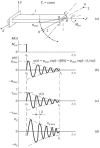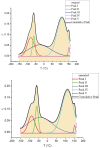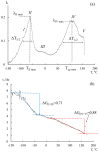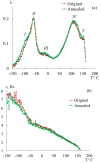Temperature Areas of Local Inelasticity in Polyoxymethylene
- PMID: 39771433
- PMCID: PMC11679218
- DOI: 10.3390/polym16243582
Temperature Areas of Local Inelasticity in Polyoxymethylene
Abstract
The spectra of internal friction and temperature dependencies of the frequency of a free-damped oscillation process excited in the specimens of an amorphous-crystalline copolymer of polyoxymethylene with the co-monomer trioxane (POM-C) with a degree of crystallinity ~60% in the temperature range from -150 °C to +170 °C has been studied. It has been established that the spectra of internal friction show five local dissipative processes of varying intensity, manifested in different temperature ranges of the spectrum. An anomalous decrease in the frequency of the oscillatory process was detected in the temperature ranges where the most intense dissipative losses appear on the spectrum of internal friction. Based on phenomenological model representations of a standard linear solid, the physical-mechanical (shear modulus defect, temperature position of local regions of inelasticity) and physical-chemical (activation energy, discrete relaxation time, intensities of detected dissipative processes) characteristics of each local dissipative process were calculated. It was found that the intensities of dissipative processes remain virtually unchanged for both annealed and non-annealed samples. The maximum variation in the shear modulus defect is 0.06%. Additionally, according to computational data, small changes are also characteristic of the following parameters: the activation energy varies from 0.5 to 1.4 kJ/mol and the relaxation time changes from 0.002 to 0.007 s, depending on the presence or absence of annealing. As a result of annealing, there is a significant increase in the relaxation microinheterogenity of the polymer system across the entire temperature range (250% for the low-temperature region and 115% for the high-temperature region).
Keywords: dissipation mechanisms; internal friction spectra; local dissipative processes; polyoxymethylene; relaxation time; shear modulus defect; temperature–frequency dependencies.
Conflict of interest statement
The authors declare no conflicts of interest.
Figures








References
-
- Jiang Z., Chen Y., Liu Z. The morphology, crystallization and conductive performance of a polyoxymethylene/carbon nanotube nanocomposite prepared under microinjection molding conditions. J. Polym. Res. 2014;21:451. doi: 10.1007/s10965-014-0451-2. - DOI
-
- Hama H., Tashiro K. Structural changes in isothermal crystallization process of polyoxymethylene investigated by time-resolved FTIR, SAXS and WAXS measurements. Polymer. 2003;44:6973–6988. doi: 10.1016/j.polymer.2003.08.019. - DOI
-
- Hama H., Tashiro K. Structural changes in non-isothermal crystallization process of melt-cooled polyoxymethylene. [I] Detection of infrared bands characteristic of folded and extended chain crystal morphologies and extraction of a lamellar stacking model. Polymer. 2003;44:3107–3116. doi: 10.1016/S0032-3861(03)00207-6. - DOI
-
- Hasegawa S., Takeshita H., Yoshii F., Sasaki T., Makuuchi K., Nishimoto S. Thermal degradation behavior of gamma-irradiated acetyloxy end-capped poly(oxymethylene) Polymer. 2000;41:111–120. doi: 10.1016/S0032-3861(99)00131-7. - DOI
-
- Lüftl S., Archodoulaki V.-M., Seidler S. Thermal-oxidative induced degradation behaviour of polyoxymethylene (POM) copolymer detected by TGA/MS. Polym. Degrad. Stab. 2006;91:464–471. doi: 10.1016/j.polymdegradstab.2005.01.029. - DOI
LinkOut - more resources
Full Text Sources
Research Materials
Miscellaneous

